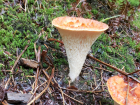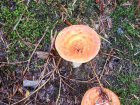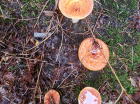Fruiting body initially cylindrical, maturing to trumpet- or vase-shaped. There is no clear demarcation between the cap and stipe. The stripe it is solid in younger specimens, though is often hollowed out by insect larvae in older ones. At higher elevations, two or three fruit bodies may arise from one stipe. Coloured with various shades of reddish- to yellowish-orange, the cap surface is broken into scales, with the spaces between more yellow and the scales themselves more orange. The white flesh is fibrous and thick, though thins with age. Somewhat brittle, it can sometimes turn brown when cut or bruised. Spore print yellowish to pale buff.
Microscopic Features: Spores measure 11–16 x 5.5–7 µm and are ellipsoid in shape, with a snout-like apical end; they have a finely verrucose surface and appear hyaline to ochraceous in potassium hydroxide (KOH) solution; they are inamyloid.
Turbinellus floccosus on the MushroomExpert.Com web site.
Many mushrooms are poisonous, and some can be lethally toxic. Distinguishing between edible and poisonous mushrooms can be very challenging. Therefore, we strongly advise against consuming wild mushrooms. This website does not contain any information about the edibility or toxicity of mushrooms.
Although efforts have been made to ensure accuracy on this website, the information may contain errors and omissions. Therefore, all content provided is for educational and informational purposes only and should not be relied upon or used as a basis for consuming any plants or mushrooms.
External links are provided for reference only. We do not endorse or take responsibility for the content, advice, or products found on these sites or in any advertisements shown on this website.


